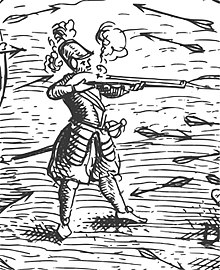Samuel de Champlain
| Samuel de Champlain | |
|---|---|

Detail from "Deffaite des Yroquois au Lac de Champlain," from Champlain's Voyages (1613). This self-portrait is the only surviving contemporary likeness of the explorer.
|
|
| Born |
Samuel Champlain baptised August 13, 1574 Brouage or La Rochelle, Aunis, France |
| Died | December 25, 1635 (aged 61) Quebec City, Canada |
| Occupation | navigator, cartographer, soldier, explorer, administrator and chronicler of New France |
| Known for | exploration of New France, foundation of Quebec City, being called The Father of New France |
| Signature | |
Samuel de Champlain (French: [samɥɛl də ʃɑ̃plɛ̃] born Samuel Champlain; on or before August 13, 1574 – December 25, 1635), "The Father of New France", was a French navigator, cartographer, draughtsman, soldier, explorer, geographer, ethnologist, diplomat, and chronicler. He founded New France and Quebec City on July 3, 1608. He is important to Canadian history because he made the first accurate map of the coast and he helped establish the settlements.
Born into a family of mariners, Champlain, while still a young man, began exploring North America in 1603 under the guidance of François Gravé Du Pont, his uncle. From 1604 to 1607 Champlain participated in the exploration and settlement of the first permanent European settlement north of Florida, Port Royal, Acadia (1605) as well as the first European settlement that would become Saint John, New Brunswick (1604). Then, in 1608, he established the French settlement that is now Quebec City. Champlain was the first European to explore and describe the Great Lakes, and published maps of his journeys and accounts of what he learned from the natives and the French living among the Natives. He formed relationships with local Montagnais and Innu and later with others farther west (Ottawa River, Lake Nipissing, or Georgian Bay), with Algonquin and with Huron Wendat, and agreed to provide assistance in their wars against the Iroquois.
...
Wikipedia
